Combining Colors for Quilts
Dudley is one of the Artistic Artifacts staff members, always happy to assist a customer with choosing fabrics. She has helped start many talented quilters on their way through her classes. Enjoy her thoughts on fabric selection! — Judy
Guest post by Dudley Shugart

I have been asked many times to teach a class on color theory to help people select fabrics to make a quilt. Since I am not a color wheel user, I wanted to share some of my thoughts on how I go about selecting fabric for my quilts in this post.
First off, I do begin with a quilt pattern I want to use, deciding on two colors, or a particular fabric to build around.
Let’s start with my favorite quilt pattern — Yellow Brick Road by Atkinson Designs. I have used this pattern probably more than fifty times! It is my 'go-to' baby quilt and other occasions when I want to gift a quilt.

The pattern calls for six fat quarters to make a baby quilt size. Having made many of these quilts over the years, in my opinion the quilt looks better featuring three different colors (with two different shades or variations of each of your three colors) rather than six completely different colors.

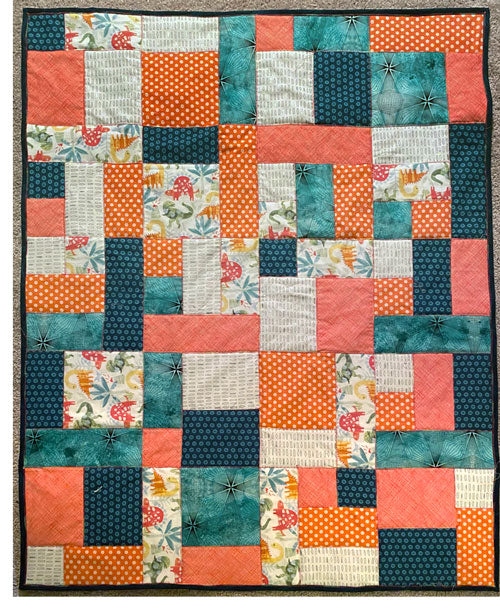
For a baby quilt gift, I usually begin with a fun children's or novelty pattern or focus fabric, then find a complementary fabric with similar colors to go with the focus fabric. I have examples of some of my Yellow Brick Road quilts included in this post, and pictured here is the one I made for a special little boy, Leo, the son of my Artistic Artifacts coworker Katelyn — her baby shower was dinosaur-themed and she was in love with this focal fabric.
After selecting the first two 'busier' fabric patterns, I select two colors that enhance the focus fabric I initially selected. From this point, selecting different scales of print and lights and darks add interest too. As a personal rule, I try never to use the same print twice. Also, I like to not use fabrics from the same fabric collection or line if I can get away with it!
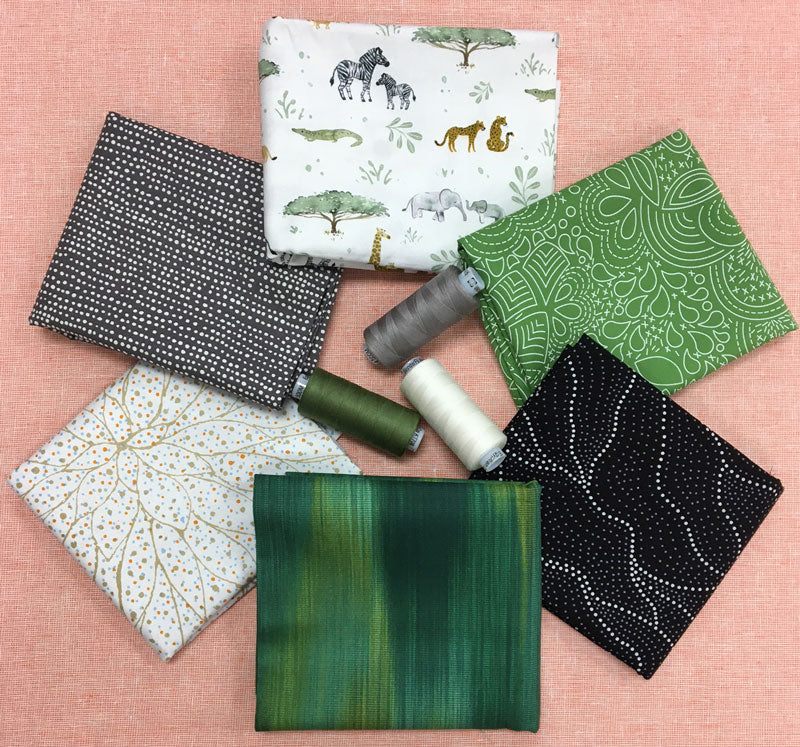
I took a trip through Artistic Artifacts to assemble this example six-fabrics selection that would be the basis of a beautiful Yellow Brick Road quilt. Of course many other quilt patterns, or repeats of your favorite patchwork block patterns, would look great with fabrics like these too.

- I decided to build my selections around this novelty print with a white background: Let's Get Wild! by Clara Jean is fabric one, pictured above left.
- Fabric two: I liked the lines and dots of The Fallen Seeds Ecru by Gracie Morton.
- Fabric three: Time to pick a green to go with my jungle animals. Visual Vibes by Laura Berringer, Greenended up having great shades to coordinate and I think of this as a tone on tone.
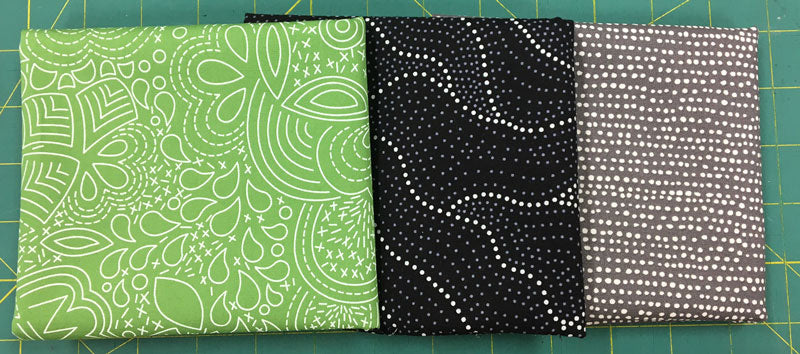
- Fabric four: Another green. After trying out several, I ended up with Hopscotch- Stitched, Pickle. It's the perfect lighter shade of green to accent the trees in my focus fabric, and the white line pattern has a fun interpretation of flower and leaves.
- Fabric five: Now to bring in black, for contrast. Another Australian Aborigine-designed fabric was my choice: Land of Utopia Black by Anna Pitjarais a beautiful fabric with visual flow.
- Fabric six: The blender line Moonscape by Dear Stella is a real favorite here in the shop — it goes with so many fabrics. Asphalt is a new color choice for us, a nice medium gray.
The three pairs of fabric colors I discussed earlier are, in this instance, white, green, and black. Remember too that variation of print is as important as color for the final effect.

And here’s an additional tip. You’ll know you have a successful combination when you move the fabric bolts or swatches around in order on your cutting table or work surface, and the fabrics still look good together. If you find that you’re considering a fabric that only looks good paired with one other fabric, and/or with a shift in order it stands out, try again.
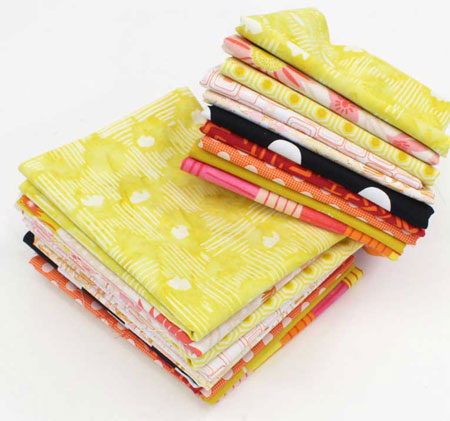
When Artistic Artifacts staff created their own curated 10 fat quarter cut bundles to sell during our April 28 Facebook/CommentSold live sale event, I expanded the six-fabric idea to create mine.
We were challenged to mix lines and designers, even to incorporate fabrics on sale and to consider bolts that hadn’t gotten enough attention when released, not just the newest arrivals. Here are my thoughts behind my selections.
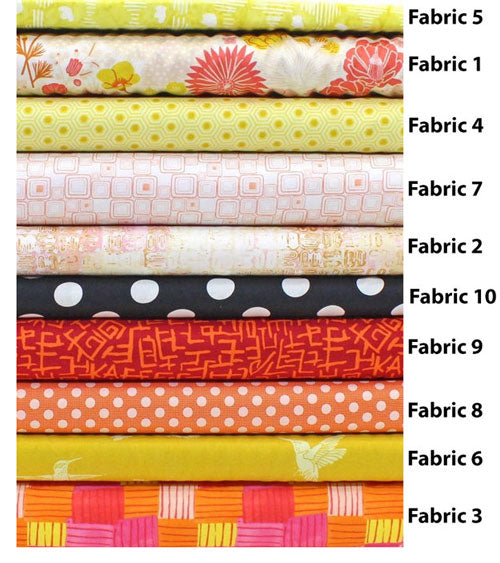
- Fabric one: Fabric with pink, gold and orange flowers (Prickly Pear by Emily Taylor, Flowers) — the design of the flowers is very clear and graphic
- Fabric two: A multicolor fabric with the colors of fabric one (Wishwell: Weather Report by Leslie Tucker Jenison, Sunrise). With this print, those similar colors are a little more blended together.
- Fabric three: the strong pink, yellow and orange weave print (Fresh Picked by Sarah Campbell, Garden Patch Hot). Notice how this is a large-scale graphic print.
- Fabric four: a small print blender featuring yellow dots (Tula’s True Colors, Hexy, Sunshine) — this shade of yellow is taken from the original fabric one flowers.
- Fabric five: a yellow-green batik (Island Home Batiks by Natalie Barnes, Woven in Palm), with a design pattern that is more irregular.
- Fabric six: This large bold graphic of flying birds (Murmur by Valori Wells, Hummingbirds, Gold) is the darkest color of the yellow/gold family.
- Fabric seven: Orange with white simple pattern (Natural Affinity, Parquet, Apricot). A very light fabric, this goes with the background of the focus fabric.
- Fabric eight: orange polka dots (Tilda Medium Dots, Ginger) — medium color value; clear, medium-scale print.
- Fabric nine: dark orange random print (Kaffe Fassett Collective Aug 2021, Amaze, Red), which adds a strong, dark influence.
- Fabric ten: black and white dots (Tula Pink Linework, Pom Poms in Ink) — a super strong contrast that adds a pop to the collection. A fabric like this keeps your quilt from looking like it came from a department store!
This is my approach, and it is just one way to explore combining colors. Remember that your projects are yours, so choose fabric you love!
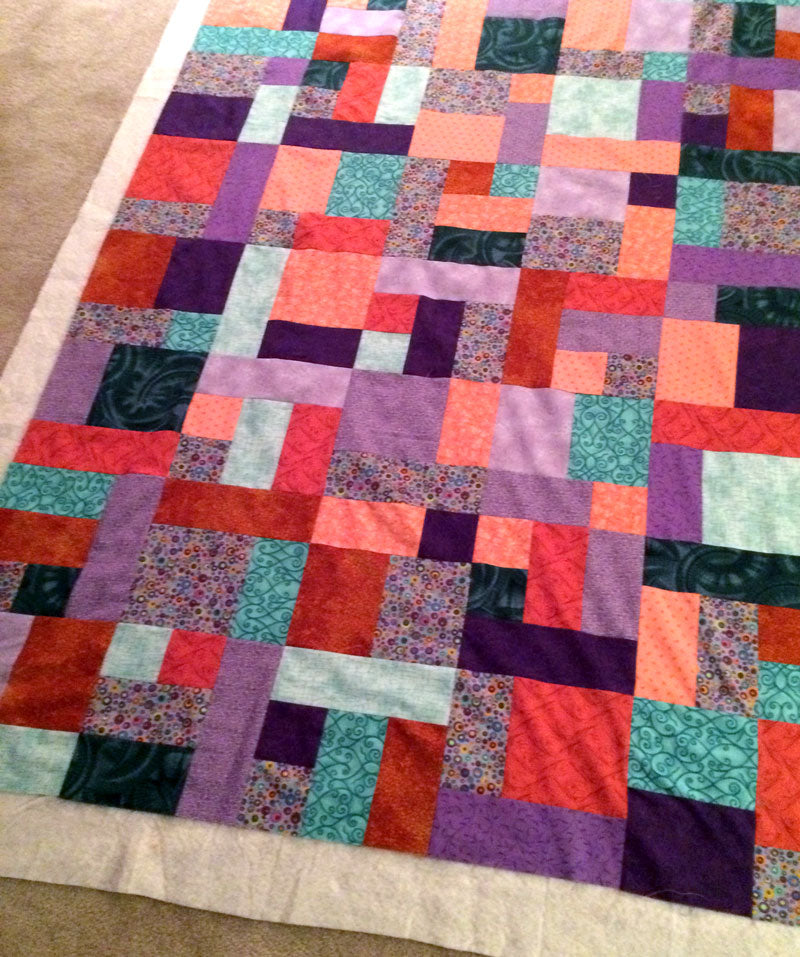
Above, while I focused on the baby quilt size of Yellow Brick Road, the instructions are included to create six different sizes — it's an easy pattern to stitch and gives you a fun scrappy look.



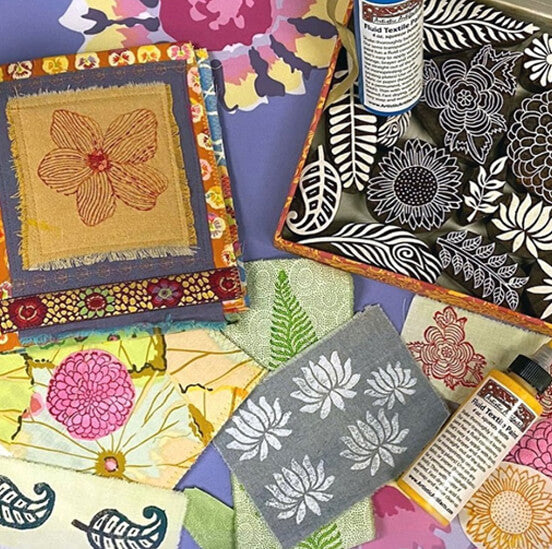



Leave a comment